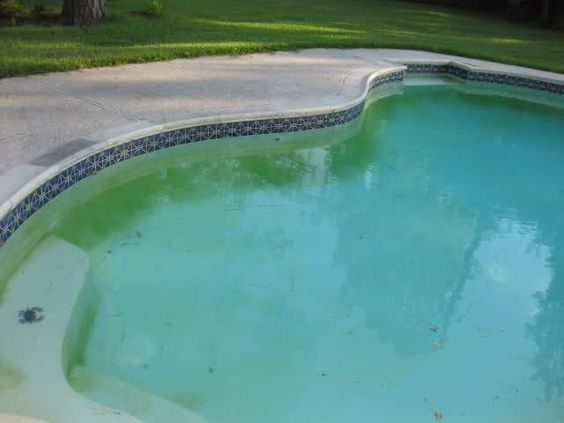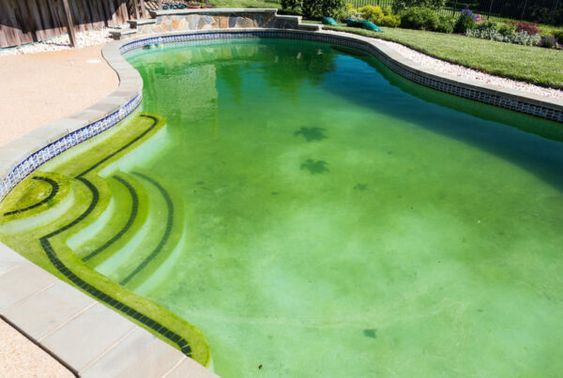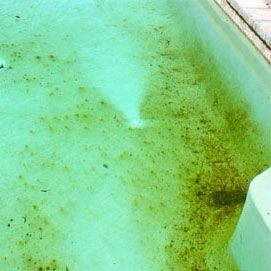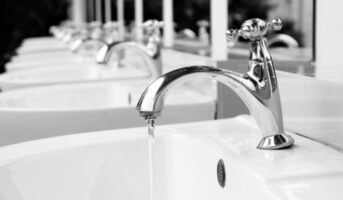Algae are microscopic organisms that flourish in warm, nutrient-rich environments like swimming pools. Algae deposits slimy, fuzzy coatings on pool surfaces and water. It is never safe to swim in a pool that has algae because it has dangerous bacteria such as E. coli. Algae grow as a result of inadequate maintenance. It is important to clean the algae formed as soon as you notice them, as it can clog the filter and cause irritation to your skin and eyes.
See also: Swimming pool at home: Everything you need to know

Source: Pinterest (River pools and spas)
Factors contributing to algae growth
- Insufficient chlorine levels: Pool water with low levels of chlorine helps in algae growth.
- No water circulation: Poor water circulation leads the water to sit still and thus grow algae.
- Exposure to sunlight: Algae depend upon sunlight, which is needed for their growth. Pools that receive direct sunlight provide ideal conditions for algae growth.
- Inadequate pool maintenance: Algae often grows in pools that are not cleaned regularly. Fallen leaves, grass and debris lead to the growth of algae.
Types of algae
- Green algae: The most common type of algae is green algae. Your pool appears cloudy green due to green algae.

Source: Pinterest (Nautilus br)
- Mustard algae: Yellowish-brown spots of mustard algae appear on pool walls and surfaces. Removing them can be more challenging and difficult.

Source: Pinterest (Swim University)
- Black algae: Black algae are the hardest to get rid of because they form hard spots on the surfaces of the pool.

Source: Pinterest (Clean pool and spa)
How to remove algae from a pool?
Test pool’s pH
First, check the pH level of the water in the pool using a pH testing kit. The pH range for pool water should be between 7.2 and 7.6. If the pH level of pool water is outside of this range, you should treat it. You can lower the pH of your pool by adding a pH reducer such as sodium bisulfate or muriatic acid. To increase the pH of your pool, use a pH increaser such as sodium carbonate or soda ash. Follow the manufacturer’s instructions.
Shock the pool
Shocking the pool is required to kill the algae and sanitise the water. The amount of shock required depends upon the severity of the algae and the type of algae present. While green algae require a small amount, mustard and black need a large amount. Pour a bucket of water with the shock dissolved in it around the pool’s surfaces. Follow the manufacturer’s instructions and make sure to wear gloves and goggles all the time.
Add algaecide
After shocking the pool, it is recommended to add an algaecide to prevent algae from coming back and to kill any remaining spores. Based on the type of algae infestation you have, choose an appropriate algaecide. For the amount and application, follow the manufacturer’s instructions.
Scrub the pool
Scrub the walls and floor of the swimming pool with a brush. Pay close attention to the areas where algae tend to collect, such as walls, floors, steps, and other corners.
Vacuum and backwash the pool
Now, for the final step, you need to vacuum the pool to remove any floating dead algae and debris. Use a pool vacuum to clean the water thoroughly.
To help the water circulate and get rid of any leftover debris or algae, run your pool filter. Backwashing the pool also helps in the removal of any trapped debris.
FAQs
How is algae harmful?
Alage makes the surface of the pool slippery and affects the water quality, which can cause allergies.
How can I stop algae from forming again?
Regularly clean the pool; run the filter regularly so that the pool water does not sit still; maintain balanced pH and sanitiser levels; when the pool is not in use, use a pool cover.
Can algae return after treatment?
Yes, algae can return again if the cause of its growth is not solved. It is important to take the necessary precautions.
Do I need to hire a professional?
If the following steps do not work or the algae has grown severely, it is best to hire a professional.
Can I remove algae naturally?
Natural techniques can help to prevent algae growth to some extent, but they might not be useful in cases of extreme algae growth.
Is algae bad for water?
The excess growth of algae in water consumes oxygen and blocks sunlight from underwater plants. This can damage aquatic life.
Why does algae grow?
Thick layers of algae form when nutrients such as phosphorus and nitrogen build up in water in excess amounts in the presence of sunlight.
| Got any questions or point of view on our article? We would love to hear from you. Write to our Editor-in-Chief Jhumur Ghosh at [email protected] |
Housing News Desk is the news desk of leading online real estate portal, Housing.com. Housing News Desk focuses on a variety of topics such as real estate laws, taxes, current news, property trends, home loans, rentals, décor, green homes, home improvement, etc. The main objective of the news desk, is to cover the real estate sector from the perspective of providing information that is useful to the end-user.
Facebook: https://www.facebook.com/housing.com/
Twitter: https://twitter.com/Housing
Email: [email protected]











